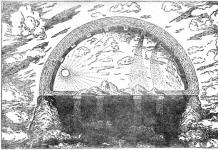Sulfur and its compounds.
Equipment, reagents:
Sulfur (small pieces), sulfur (powder), reduced iron, dry sodium sulfite, concentrated sulfuric acid, copper, sodium hydroxide, phenolphthalein, fuchsin, sugar, crystalline potassium permanganate, alcohol, copper (II) oxide.
Large test tubes - 5 pcs., small test tubes - 6 pcs., a test tube rack, a prefabricated rack, a mortar and pestle, a small crucible, a small flask with a gas outlet tube and a dropping funnel, a small glass, glass stirring rods, flasks, cotton wool, porcelain cups, tiles. electric.
Sulfur and its properties
Features of sulfur melting.
Small pieces of sulfur are placed in a test tube to fill 1/3 of its volume (sulfur color is less suitable for these purposes, since strong foaming is observed when it melts). The test tube with sulfur is heated until the sulfur melts (119 "C). With further heating, the sulfur darkens and begins to thicken (maximum thickening at 200 "C). At this point, the test tube is turned upside down for a moment, and the sulfur will not spill out. With even stronger heating, the sulfur liquefies again, and at 445 "C it boils. Boiling sulfur is poured into a glass or crystallizer with water, while making a circular motion with the test tube. Plastic sulfur solidifies in the water. If you remove it from the water (using a glass rod) , then it stretches like rubber.
Reaction between sulfur and iron.
a) The experiment is carried out in a test tube. First, prepare a mixture of substances in a ratio of 7: 4
(Ar(Fe): Ar(S) = 56: 32). For example, it is enough to take 3.5 g of iron and 2 g of sulfur. In the resulting mixture, individual particles of sulfur and iron and the color of these substances are distinguishable. If you throw a little of the mixture into a glass of water, the sulfur floats (not wetted by water), and the iron sinks (wetted by water).
The mixture can be separated using a magnet. To do this, a magnet is brought to the mixture on a watch glass or glass plate covered with paper, which attracts iron, the sulfur remains on the watch
glass The mixture is transferred into a test tube, which is fixed in a tripod leg at a slightly inclined angle and heated. It is enough to achieve the start of the reaction (red-hot) in one place of the mixture - and the reaction continues by itself (the process is exothermic). To extract the resulting iron sulfide, the test tube is broken. So, from two substances, if they were taken in quantities corresponding to the calculations, one substance was obtained, having properties different from the properties of the original substances.
Possible problems during the experiment
1. For the experiment, you need to take only reduced iron. When using ordinary sawdust, the reaction does not occur, since each grain is covered with a thin film of iron oxides, which
prevents the contact of iron with sulfur.
2. The reaction will not proceed or only isolated outbreaks will be observed if the mixture is poorly mixed and there is not sufficient contact of sulfur with iron.
3. The reaction will not work if the grains of iron are very large, therefore, the surface of contact with sulfur is small.
Sulfur (IV) oxide and sulfurous acid.
Preparation of sulfur (IV) oxide.
a) The flask with solid sodium sulfite is closed with a stopper and a dropping funnel. When adding concentrated sulfuric acid (the acid must be added drop by drop. When observed
strong gas evolution, then the addition of acid is stopped) sulfur oxide (IV) is released. The reaction occurs without heating.
b) Concentrated copper is added to copper (shavings, sawdust or wire). sulfuric acid and heat up. Sulfur (IV) oxide is collected by displacing air.
Dissolution of sulfur (IV) oxide in water.
Place the cylinder with the hole facing up and fill it with sulfur (IV) oxide. The completeness of filling is controlled as with carbon dioxide with a burning torch. The cylinder is covered with glass
plate and hole downwards are lowered into a crystallizer with water. When the cylinder is rocked, water gradually enters it. The solubility of sulfur (IV) oxide in water is very high and at room conditions is on average 40 volumes of gas per 1 volume of water, which is approximately 10% by weight. High solubility always allows students to conclude that in this case a chemical reaction occurs between the dissolving gas and the solvent.
reaction.
Chemical properties sulfurous acid.
100 - 150 ml of water is poured into a flask and sulfur (IV) oxide is passed through for several minutes so that the solution has a strong odor. This bottle is closed with a stopper.
a) 1/3 of the volume of the test tube is filled with water tinted with magenta. Add sulfurous acid to the colored water and stir the solution. Sulfurous acid gives a colorless solution with organic dyes. Heat the solution to a boil. The magenta color is restored again. Why?
Sulfur and its compounds are among the most important classes pesticides.
Sulfur is a yellow solid. There are crystalline and amorphous varieties. Sulfur does not dissolve in water, it dissolves well in carbon disulfide, aniline, phenol, benzene, gasoline, and poorly in alcohol and chloroform. At elevated temperature combines with oxygen, metals and many non-metals. Available in the form of 80-90% wetting powder, 70-75% colloidal sulfur, and ground sulfur.
Ground sulfur does not dissolve in water and is poorly wetted by it.
Colloidal sulfur It is well wetted with water and, when shaken or stirred, creates persistent cloudy suspensions. Evaporates weakly and slowly.
Produced and transported in metal and wooden barrels; and also in paper bags treated with a waterproof substance. When stored in loose containers, colloidal sulfur dries out, turning into lumps, and then mixes very poorly with water.
In animal husbandry, colloidal sulfur is used to combat psoroptosis in cattle by spraying animals with a 3% aqueous suspension with a consumption of 3-4 liters per animal, twice, with an interval of 7-10 days.
Sulfur is low toxic. Acute poisoning when working with it is excluded. However, prolonged inhalation may cause respiratory problems.
Sulfur cuttings- molten sulfur turned into a cylindrical shape. Lit. When 1.4 g is burned, 1 liter of sulfur dioxide is obtained. The antiparasitic effect of sulfur is due to the formation of sulfur dioxide, hydrogen sulfide, oxygen, in the presence of moisture, alkalis and organic compounds. In concentrations of 5-8%, sulfur has a softening, keratoplastic, anti-inflammatory effect and a weak anti-scabies, and in high concentrations, due to the formation of sulfuric and sulfurous acids, irritating, drying and keratolytic effects develop. Sulfur cuttings are used to treat animals suffering from scabies, trichophytosis, microsporia, furunculosis, seborrhea, eczema, dermatitis in the form of 10-30% purified sulfur ointment or 5-10 and 20% precipitated sulfur ointment, as well as in the form of liniments and dusts.
To treat scabies, use sulfur ointment (sulfur 6 parts, green soap - 8, potassium carbonate - 1 and petroleum jelly - 10 parts).
Purified sulfur- sulfur, free from all impurities, is produced in powder in carefully closed containers. Purified sulfur has an antiparasitic and antidote effect against many poisonings. It is used in all cases as cutting sulfur.
Sulfur precipitated- purified from many impurities. Lit. When burned, sulfur dioxide is formed, which has antiparasitic and insecticidal effects. Pharmacodynamics and mechanism of action are the same as those of cutting sulfur. Available in powder form, in well-closed jars.
Sodium sulfate- a sulfur-containing substance with an antiparasitic effect. The mechanism of action is the formation of sulfur dioxide and sulfur during the interaction of sodium thiosulfate molecules with a molecule of acids or acid salts, as a result of which the redox processes in the parasites sharply change.
It is produced in powder form, which must be stored in a well-closed container.
Demos- an acaricidal drug, which includes sulfur and auxiliary components. This is a light brown liniment with a weak specific odor. The drug is produced in glass or plastic bottles with a capacity of 10, 15 and 20 ml. Store demos at a temperature of 0-25°C in a place protected from light. Shelf life - 2 years from the date of manufacture.
Demos is active against sarcoptoid mites - the causative agents of psoroptic mange in rabbits, otodectic mange in carnivores, notoedrosis in cats, as well as against the causative agent of demodicosis in dogs.
The drug has low toxicity for warm-blooded animals, it does not have an irritating or sensitizing effect.
When treating animals with ear scabies, first thoroughly clean the auricles from scabs with a swab soaked in camphor alcohol, then inject 1.5-3.0 ml of demos into the auricle using a pipette and lightly massage the auricle at the base. If other parts of the body are affected, the drug is rubbed into the affected areas using a cotton gauze swab at the rate of 0.1-0.3 cm of adjacent healthy skin.
Animals with large areas of skin lesions are treated in 2 doses, with an interval of 1 day, applying the drug first to one half and then to the other half of the affected surface of the body.
Plison(diphenyl disulfide), C12H10S2. Obtained by mixing coal oil 22-42%, diphenyl sulfide 6-10%, emulsifier OP-7 (rosin) or OP-10 (neonol) - 15-20% and water up to 100%. Diphenyl disulfide is produced as a by-product in the production of coal-tar phenols.
Plizon is a homogeneous, dark-colored oily liquid. The aqueous emulsion of this drug is stable for 4 hours at room temperature. The drug is low-toxic; when applied cutaneously, the LD50 is 12,500 mg/kg. 0.5% plison emulsion (therapeutic concentration) is well tolerated by sheep and is not accompanied by changes in the morphological picture of the blood. Plizone 2% causes a decrease in the activity of cholinesterase and alkaline phosphatase on the first day after purchase, without the manifestation of clinical signs of toxicosis.
Plizon, according to research by O.D. Yanyshevsky et al., is excreted from the internal organs and tissues of sheep treated with a 0.5% emulsion after 40 days, and from fat after 65. In animals treated with a 0.25% plison emulsion, diphenyl disulfide was absent in the internal organs and tissues after 20 days. It persists on sheep wool for up to 5 months in an amount of 15.1 mg/kg. It is not excreted in the milk of suckling ewes.
Lepran- a sulfur-containing product from the processing of benzothiophene coal tar. The liquid is dark brown in color with the smell of coal oil. When mixed with water, lepran forms a stable light brown emulsion. The drug consists of benzothiophene - 10-14%, coal oil 57-64, emulsifier 25-30 and water up to 100%. Lepran is low toxic, its LD50 when buying sheep is 14250 mg/kg. The cumulation coefficient is more than 5.28, which indicates weak cumulative properties, and does not have allergenic or irritating properties to the skin and mucous membranes. When treating sheep (one-time purchase) with 2% leprane emulsion (0.22% DDV), according to research by B.A. Timofeev, the drug does not have mutagenic properties, does not change hematological parameters of phosphatase, veterinary and sanitary indicators of the quality of sheep meat. 50 days after treatment, benzothiophene is not detected in the organs and tissues of sheep, the meat is suitable for release and sale for food purposes. Benzothiophene is not excreted in milk; the drug can be used to treat pregnant and lactating sheep.
In cases of poisoning of animals with sulfur-containing drugs, activated carbon, burnt magnesia, and a laxative are used internally.
The content of the article
SULFUR, S (sulfur), non-metallic chemical element, member of the chalcogen family (O, S, Se, Te and Po) – Group VI periodic table elements. Sulfur, like many of its uses, have been known since ancient times. A. Lavoisier argued that sulfur is an element. Sulfur is vital for the growth of plants and animals; it is part of living organisms and their decomposition products; there is a lot of it, for example, in eggs, cabbage, horseradish, garlic, mustard, onions, hair, wool, etc. It is also present in coals and oil.
Application.
About half of annual sulfur consumption goes into the production of industrial chemicals such as sulfuric acid, sulfur dioxide and carbon disulfide (carbon disulfide). In addition, sulfur is widely used in the production of insecticides, matches, fertilizers, explosives, paper, polymers, paints and dyes, and in the vulcanization of rubber. The leading place in sulfur production is occupied by the USA, CIS countries and Canada.
Prevalence in nature.
Sulfur occurs in a free state (native sulfur). In addition, there are huge reserves of sulfur in the form of sulfide ores, primarily the ores of lead (lead luster), zinc (zincblende), copper (copper luster) and iron (pyrite). When metals are extracted from these ores, they are freed from sulfur, usually by roasting in the presence of oxygen, which produces sulfur dioxide (IV), which is often released into the atmosphere without use. In addition to sulfide ores, quite a lot of sulfur is found in the form of sulfates, for example, calcium sulfate (gypsum), barium sulfate (barite). Sea water and many mineral waters contain water-soluble magnesium and sodium sulfates. Hydrogen sulfide (hydrogen sulfide) is found in some mineral waters. In industry, sulfur can be obtained as a by-product of processes in smelters, coke ovens, oil refining, from flue gases or natural gases. Sulfur is extracted from natural underground deposits by melting it with superheated water and delivering it to the surface using compressed air and pumps. In the flash process for extracting sulfur from sulfur deposits using a concentric pipe installation, patented by G. Frasch in 1891, sulfur is obtained with a purity of up to 99.5%.
Properties.
Sulfur has the form of a yellow powder or brittle crystalline mass, odorless and tasteless and insoluble in water. Sulfur is characterized by several allotropic modifications. The most famous are the following: crystalline sulfur - orthorhombic (native sulfur, a-S) and monoclinic (prismatic sulfur, b-S); amorphous - colloidal (sulfur milk) and plastic; intermediate amorphous-crystalline - sublimated (sulfur color).
Crystalline sulfur.
Crystalline sulfur has two modifications; one of them, orthorhombic, is obtained from a solution of sulfur in carbon disulfide (CS 2) by evaporating the solvent at room temperature. In this case, diamond-shaped translucent crystals of light yellow color are formed, easily soluble in CS 2. This modification is stable up to 96° C, at more high temperature monoclinic form is stable. With the natural cooling of molten sulfur in cylindrical crucibles, large crystals of the orthorhombic modification with a distorted shape (octahedra with corners or faces partially “cut off”) grow. This material is called lump sulfur in industry. The monoclinic modification of sulfur is long transparent dark yellow needle crystals, also soluble in CS 2. When monoclinic sulfur is cooled below 96° C, a more stable yellow orthorhombic sulfur is formed.
Non-crystalline sulfur.
In addition to these crystalline and amorphous forms, there is an intermediate form known as sulfur color or sublimated sulfur, which is produced by the condensation of sulfur vapor without passing through the liquid phase. It consists of tiny grains with a crystallization center and an amorphous surface. This form dissolves slowly and incompletely in CS 2 . After treatment with ammonia to remove impurities such as arsenic, the product is known medically as washed sulfur, which is used in a similar way to colloidal sulfur.
Liquid state.
Sulfur molecules consist of a closed chain of eight atoms (S 8). Liquid sulfur has an unusual property: with increasing temperature, its viscosity increases. Below 160° C, sulfur is a typical yellowish liquid, its composition corresponds to the formula S 8 and is designated l-S. As the temperature rises, the ring molecules of S8 begin to break and join together, forming long chains ( m-S), the color of liquid sulfur becomes dark red, viscosity increases, reaching a maximum at 200–250 ° C. With a further increase in temperature, liquid sulfur becomes lighter, long chains break, forming short ones, with less ability to intertwine, which leads to lower viscosity.
Gas.
Sulfur boils at 444.6° C, forming orange-yellow vapors consisting mainly of S 8 molecules. With increasing temperature, the color of the vapor turns into dark red, then into fawn, and at 650° C into straw yellow. With further heating, the S 8 molecules dissociate, forming the equilibrium forms S 6, S 4 and S 2 at different temperatures. And finally, at >1000° C the vapors consist practically of S 2 molecules, and at 2000° C they consist of monatomic molecules.
Chemical properties.
Sulfur is a typical non-metal. It has six electrons on its outer electron shell, and it more easily attaches electrons to other elements than gives up its own. It reacts with many metals, releasing heat (for example, when combined with copper, iron, zinc). It also combines with almost all non-metals, although not as vigorously.
Connections.
Sulfur dioxide
is formed when sulfur is burned in air, in particular during the roasting of sulfide metal ores. Sulfur dioxide is a colorless gas with a suffocating odor. It is an anhydride of sulfurous acid and readily dissolves in water to form sulfurous acid. The dioxide easily liquefies (boiling point -10°C) and is stored in steel cylinders. Dioxide is used in the production of sulfuric acid, in refrigeration units, for bleaching textiles, wood pulp, straw, beet sugar, for preserving fruits and vegetables, for disinfection, in brewing and food production.
Sulfurous acid
H 2 SO 3 exists only in dilute solutions (less than 6%). It is a weak acid that forms medium and acid salts (sulfites and hydrosulfites). Sulfurous acid is a good reducing agent and reacts with oxygen to form sulfuric acid. Sulfurous acid has several applications, including bleaching silk, wool, paper, wood pulp and similar substances. It is used as an antiseptic and preservative, especially to prevent the fermentation of wine in barrels, to prevent the fermentation of grains during the extraction of starch. Acid is also used to preserve food. Highest value of its salts is calcium hydrosulfite Ca(HSO 3) 2, used in the processing of wood chips into cellulose.
Sulfur trioxide
SO 3 (sulfuric anhydride), which forms sulfuric acid with water, is either a colorless liquid or white crystalline substance(crystallizes at 16.8° C; bp 44.7° C). It is formed by the oxidation of sulfur dioxide with oxygen in the presence of an appropriate catalyst (platinum, vanadium pentoxide). Sulfur trioxide smokes strongly in moist air and dissolves in water, forming sulfuric acid and generating a lot of heat. It is used in the production of sulfuric acid and the production of synthetic organic matter.
Sulfuric acid
H2SO4. Anhydrous H 2 SO 4 is a colorless oily liquid that dissolves SO 3 to form oleum. Miscible with water in any ratio. When dissolved in water, hydrates are formed with the release of a very large amount of heat; therefore, in order to avoid splashing of the acid, it is usually necessary to carefully add the acid to the water when dissolving, and not vice versa. Concentrated acid absorbs water vapor well and is therefore used to dry gases. For the same reason, it leads to charring of organic substances, especially carbohydrates (starch, sugar, etc.). If it comes into contact with the skin, it causes severe burns; the vapors corrode the mucous membranes of the respiratory tract and eyes. Sulfuric acid is a strong oxidizing agent. Conc. H 2 SO 4 oxidizes HI, HBr to I 2 and Br 2, respectively, coal to CO 2, sulfur to SO 2, metals to sulfates. Dilute acid also oxidizes metals in the voltage series up to hydrogen. H 2 SO 4 is a strong dibasic acid that forms medium and acid salts - sulfates and hydrosulfates; Most of its salts are soluble in water, with the exception of barium, strontium and lead sulfates; calcium sulfate is slightly soluble.
Sulfuric acid is one of the most important products chemical industry(producing alkalis, acids, salts, mineral fertilizers, chlorine). It is obtained mainly by contact or tower method according to the following principle:
Most of the resulting acid is used in the production of mineral fertilizers (superphosphate, ammonium sulfate). Sulfuric acid serves as a starting material for the production of salts and other acids, for the synthesis of organic substances, artificial fibers, for the purification of kerosene, petroleum oils, benzene, toluene, in the manufacture of paints, etching of ferrous metals, in the hydrometallurgy of uranium and some non-ferrous metals, for the production of detergents And medicines, as an electrolyte in lead batteries and as a desiccant.
Thiosulfuric acid
H 2 S 2 O 3 is structurally similar to sulfuric acid except for the replacement of one oxygen with a sulfur atom. The most important derivative of the acid is sodium thiosulfate Na 2 S 2 O 3 - colorless crystals formed by boiling sodium sulfite Na 2 SO 3 with a sulfur color. Sodium thiosulfate (or hyposulfite) is used in photography as a fixative.
Sulfonal
(CH 3) 2 C(SO 2 C 2 H 5) 2 is a white crystalline substance, odorless, slightly soluble in water, is a narcotic and is used as a sedative and hypnotic.
Hydrogen sulfide
H 2 S (hydrogen sulfide) is a colorless gas with a strong unpleasant odor rotten eggs. It is slightly heavier than air (density 1.189 g/dm3), easily liquefies into a colorless liquid and is highly soluble in water. A solution in water is weak acid with pH ~ 4. Liquid hydrogen sulfide is used as a solvent. The solution and gas are widely used in qualitative analysis for the separation and determination of many metals. Inhaling small amounts of hydrogen sulfide causes headaches and nausea, large quantities or continuous inhalation of hydrogen sulfide causes paralysis nervous system, heart and lungs. Paralysis occurs unexpectedly, as a result of disruption of the vital functions of the body.
Sulfur monochloride
S 2 Cl 2 is a fuming, amber-colored oily liquid with a pungent odor, tearing and making breathing difficult. It smokes in moist air and decomposes with water, but is soluble in carbon disulfide. Sulfur monochloride is a good solvent for sulfur, iodine, metal halides and organic compounds. The monochloride is used for the vulcanization of rubber, in the production of printing ink and insecticides. When reacted with ethylene, a volatile liquid is formed known as mustard gas (ClC 2 H 4) 2 S, a toxic compound used as a chemical irritant.
Carbon disulfide
CS 2 (carbon disulfide) is a pale yellow liquid, toxic and flammable. CS 2 is produced by synthesis from elements in an electric furnace. The substance is insoluble in water, has a high refractive index, high pressure vapors, low boiling point (46° C). Carbon disulfide - an effective solvent for fats, oils, rubber and rubber - is widely used for the extraction of oils, in the production of artificial silk, varnishes, rubber glues and matches, the destruction of barn weevils and clothing moths, and for soil disinfection.
Chalcogens are a group of elements to which sulfur belongs. Her chemical sign— S is the first letter of the Latin name Sulfur. Compound simple substance written using this symbol without a subscript. Let's consider the main points concerning the structure, properties, production and use of this element. The characteristics of sulfur will be presented in as much detail as possible.
General characteristics and differences of chalcogens
Sulfur belongs to the oxygen subgroup. This is the 16th group in the modern long-period form of the periodic system (PS). The outdated version of the number and index is VIA. Titles chemical elements groups, chemical signs:
- oxygen (O);
- sulfur (S);
- selenium (Se);
- tellurium (Te);
- polonium (Po).
The outer electronic shell of the above elements has the same structure. In total it contains 6 that can participate in education chemical bond with other atoms. Hydrogen compounds correspond to the composition H 2 R, for example, H 2 S - hydrogen sulfide. Names of chemical elements that form two types of compounds with oxygen: sulfur, selenium and tellurium. General formulas oxides of these elements - RO 2, RO 3.
Chalcogens correspond to simple substances that differ significantly in physical properties. Most common in earth's crust of all chalcogens - oxygen and sulfur. The first element forms two gases, the second - solids. Polonium, a radioactive element, is rarely found in the earth's crust. In the group from oxygen to polonium, non-metallic properties decrease and metallic properties increase. For example, sulfur is a typical non-metal, while tellurium has a metallic luster and electrical conductivity.
Element No. 16 of the periodic table D.I. Mendeleev
The relative atomic mass of sulfur is 32.064. From natural isotopes the most common is 32 S (more than 95% by weight). Nuclides with atomic mass 33, 34 and 36. Characteristics of sulfur by position in PS and atomic structure:

- serial number - 16;
- the charge of the atomic nucleus is +16;
- atomic radius - 0.104 nm;
- ionization energy -10.36 eV;
- relative electronegativity - 2.6;
- oxidation state in compounds - +6, +4, +2, -2;
- valency - II(-), II(+), IV(+), VI (+).
Sulfur is in the third period; electrons in an atom are located at three energy levels: on the first - 2, on the second - 8, on the third - 6. All external electrons are valence. When interacting with more electronegative elements, sulfur gives up 4 or 6 electrons, acquiring typical oxidation states of +6, +4. In reactions with hydrogen and metals, the atom attracts the missing 2 electrons until the octet is filled and a stable state is achieved. in this case it is reduced to -2.
Physical properties of rhombic and monoclinic allotropic forms

Under normal conditions, sulfur atoms are connected to each other at an angle to form stable chains. They can be closed in rings, which suggests the existence of cyclic sulfur molecules. Their composition is reflected by the formulas S 6 and S 8.
The characterization of sulfur should be supplemented by a description of the differences between allotropic modifications with different physical properties.
Rhombic, or α-sulfur, is the most stable crystalline form. These are bright yellow crystals consisting of S 8 molecules. The density of rhombic sulfur is 2.07 g/cm3. Light yellow monoclinic crystals are formed by β-sulfur with a density of 1.96 g/cm3. The boiling point reaches 444.5°C.
Preparation of amorphous sulfur
What color is sulfur in its plastic state? It is a dark brown mass, completely different from the yellow powder or crystals. To obtain it, you need to melt orthorhombic or monoclinic sulfur. At temperatures above 110°C, a liquid is formed, with further heating it darkens, at 200°C it becomes thick and viscous. If you quickly pour molten sulfur into cold water, it will solidify to form zigzag chains, the composition of which is reflected by the formula S n.

Sulfur solubility
Some modifications in carbon disulfide, benzene, toluene and liquid ammonia. If organic solutions are slowly cooled, needle-shaped crystals of monoclinic sulfur are formed. When liquids evaporate, transparent lemon-yellow crystals of rhombic sulfur are released. They are fragile and can be easily ground into powder. Sulfur does not dissolve in water. The crystals sink to the bottom of the vessel, and the powder may float on the surface (not wetted).

Chemical properties
The reactions exhibit the typical non-metallic properties of element No. 16:
- sulfur oxidizes metals and hydrogen and is reduced to the S 2- ion;
- combustion in air and oxygen produces sulfur di- and trioxide, which are acid anhydrides;
- in a reaction with another more electronegative element - fluorine - sulfur also loses its electrons (oxidizes).
Free sulfur in nature
In terms of abundance in the earth's crust, sulfur is in 15th place among the chemical elements. The average content of S atoms is 0.05% of the mass of the earth's crust.
What color is sulfur in nature (native)? It is a light yellow powder with a characteristic odor or yellow crystals with a glassy luster. Deposits in the form of placers, crystalline layers of sulfur are found in areas of ancient and modern volcanism: in Italy, Poland, Central Asia, Japan, Mexico, and the USA. Often, beautiful druses and giant single crystals are found during mining.
Hydrogen sulfide and oxides in nature
In areas of volcanism, gaseous sulfur compounds come to the surface. The Black Sea at a depth of over 200 m is lifeless due to the release of hydrogen sulfide H 2 S. The formula of sulfur oxide is divalent - SO 2, trivalent - SO 3. The listed gaseous compounds are present in some oil, gas, natural waters. Sulfur is a component of coal. It is necessary for the construction of many organic compounds. When the whites of a chicken egg rot, hydrogen sulfide is released, which is why this gas is often said to have the smell of rotten eggs. Sulfur is a biogenic element; it is necessary for the growth and development of humans, animals and plants.

The importance of natural sulfides and sulfates
The characterization of sulfur will be incomplete if it is not said that the element is found not only in the form of simple substances and oxides. The most common natural compounds are salts of hydrogen sulfide and sulfuric acids. Sulfides of copper, iron, zinc, mercury, and lead are found in the minerals sphalerite, cinnabar and galena. Sulfates include sodium, calcium, barium and magnesium salts, which are formed in nature by minerals and rocks (mirabilite, gypsum, selenite, barite, kieserite, epsomite). All these compounds are used in various sectors of the economy, used as raw materials for industrial processing, fertilizers, and building materials. Some crystalline hydrates are of great medical importance.
Receipt
A yellow substance in a free state is found in nature at different depths. If necessary, sulfur is smelted from rocks, not by raising them to the surface, but by pumping superheated water into the depths. Another method involves sublimation from crushed rocks in special furnaces. Other methods involve dissolution with carbon disulfide or flotation.
Industry needs for sulfur are great, so its compounds are used to obtain the elemental substance. In hydrogen sulfide and sulfides, sulfur is in reduced form. The oxidation state of the element is -2. Sulfur is oxidized, increasing this value to 0. For example, according to the Leblanc method, sodium sulfate is reduced with coal to sulfide. Then calcium sulfide is obtained from it, treated with carbon dioxide and water vapor. The resulting hydrogen sulfide is oxidized with atmospheric oxygen in the presence of a catalyst: 2H 2 S + O 2 = 2H 2 O + 2S. Determination of sulfur obtained by different methods sometimes gives low purity values. Refining or purification is carried out by distillation, rectification, and treatment with mixtures of acids.

Application of sulfur in modern industry
Granulated sulfur is used for various production needs:
- Production of sulfuric acid in the chemical industry.
- Production of sulfites and sulfates.
- Production of preparations for plant nutrition, combating diseases and pests of agricultural crops.
- Sulfur-containing ores are processed at mining and chemical plants to produce non-ferrous metals. A related production is sulfuric acid production.
- Introduction to the composition of certain types of steel to impart special properties.
- Thanks they get rubber.
- Production of matches, pyrotechnics, explosives.
- Use for the preparation of paints, pigments, artificial fibers.
- Bleaching of fabrics.

Toxicity of sulfur and its compounds
Dust particles with an unpleasant odor irritate the mucous membranes of the nasal cavity and respiratory tract, eyes, and skin. But the toxicity of elemental sulfur is not considered particularly high. Inhalation of hydrogen sulfide and dioxide can cause severe poisoning.
If during the roasting of sulfur-containing ores at metallurgical plants the exhaust gases are not captured, they enter the atmosphere. Combining with drops and water vapor, oxides of sulfur and nitrogen give rise to so-called acid rain.
Sulfur and its compounds in agriculture
Plants absorb sulfate ions along with the soil solution. A decrease in sulfur content leads to a slowdown in the metabolism of amino acids and proteins in green cells. Therefore, sulfates are used for fertilizing agricultural crops.

To disinfect poultry houses, basements, and vegetable stores, the simple substance is burned or the premises are treated with modern sulfur-containing preparations. Sulfur oxide has antimicrobial properties, which has long been used in the production of wines and in the storage of vegetables and fruits. Sulfur preparations are used as pesticides to combat diseases and pests of agricultural crops (powdery mildew and spider mites).
Application in medicine

The great ancient healers Avicenna and Paracelsus attached great importance to the study of the medicinal properties of yellow powder. Later it was found that a person who does not receive enough sulfur from food becomes weaker and experiences health problems (these include itching and flaking of the skin, weakening of hair and nails). The fact is that without sulfur, the synthesis of amino acids, keratin, and biochemical processes in the body is disrupted.
Medical sulfur is included in ointments for the treatment of skin diseases: acne, eczema, psoriasis, allergies, seborrhea. Baths with sulfur can relieve pain from rheumatism and gout. For better absorption by the body, water-soluble sulfur-containing preparations have been created. This is not a yellow powder, but a white, finely crystalline substance. When this compound is used externally, it is included in a cosmetic product for skin care.
Plaster has long been used to immobilize injured parts of the human body. prescribed as a laxative medicine. Magnesia lowers blood pressure, which is used in the treatment of hypertension.
Sulfur in history
Even in ancient times, a yellow non-metallic substance attracted human attention. But it was not until 1789 that the great chemist Lavoisier discovered that powders and crystals found in nature were composed of sulfur atoms. It was believed that the unpleasant odor produced by burning it repels all evil spirits. The formula of sulfur oxide, which is obtained during combustion, is SO 2 (dioxide). It is a toxic gas and inhaling it is hazardous to health. Scientists explain several cases of mass extinction of people by entire villages on the coasts and in the lowlands by the release of hydrogen sulfide or sulfur dioxide from the ground or water.
The invention of black powder increased military interest in yellow crystals. Many battles have been won thanks to the craftsmen's ability to combine sulfur with other substances during the manufacturing process. Essential Connection— sulfuric acid — we also learned to use it a very long time ago. In the Middle Ages, this substance was called oil of vitriol, and salts were called vitriol. Copper sulfate CuSO 4 and iron sulfate FeSO 4 have still not lost their importance in industry and agriculture.


























